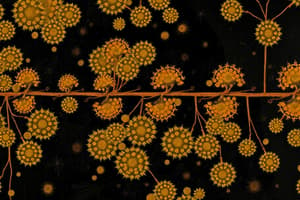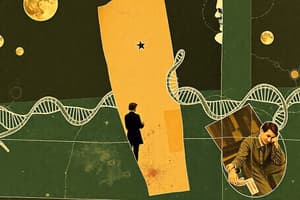Podcast
Questions and Answers
What is the default position of an inducible gene?
What is the default position of an inducible gene?
- INACTIVE
- ACTIVE
- ON
- OFF (correct)
Which of the following enzymes is encoded by the lacZ gene?
Which of the following enzymes is encoded by the lacZ gene?
- Glucosidase
- Trans-acetylase
- Beta-galactosidase (correct)
- Permease
What is the role of cyclic AMP (cAMP) in the regulation of the lac operon?
What is the role of cyclic AMP (cAMP) in the regulation of the lac operon?
- Inhibitor of lactose metabolism
- Substrate for lactose digestion
- Cellular alarm signal (correct)
- Energy source for gene transcription
Which of the following statements about the lac operon is FALSE?
Which of the following statements about the lac operon is FALSE?
What type of operon is the lac operon classified as?
What type of operon is the lac operon classified as?
Which enzymes are included in the lac operon for lactose metabolism?
Which enzymes are included in the lac operon for lactose metabolism?
How does the lac operon prevent energy wastage?
How does the lac operon prevent energy wastage?
What is described as a polycistronic mRNA in the context of the lac operon?
What is described as a polycistronic mRNA in the context of the lac operon?
What is the primary effect of a nonsense mutation on protein production?
What is the primary effect of a nonsense mutation on protein production?
What distinguishes transitions from transversions in point mutations?
What distinguishes transitions from transversions in point mutations?
What fundamental change occurs as a result of a frameshift mutation?
What fundamental change occurs as a result of a frameshift mutation?
Which of the following correctly defines a back mutation?
Which of the following correctly defines a back mutation?
How does a single base pair deletion affect the reading frame?
How does a single base pair deletion affect the reading frame?
What could potentially happen if two base pairs are inserted into a gene?
What could potentially happen if two base pairs are inserted into a gene?
What is the consequence of a mismatch where A pairs with C?
What is the consequence of a mismatch where A pairs with C?
What is the impact of a microdeletion in DNA sequence?
What is the impact of a microdeletion in DNA sequence?
What is the primary purpose of the Ames test?
What is the primary purpose of the Ames test?
Which type of bacteria is primarily used in the Ames test?
Which type of bacteria is primarily used in the Ames test?
What is meant by the term 'reversion' in the context of the Ames test?
What is meant by the term 'reversion' in the context of the Ames test?
What additional component is necessary when conducting the Ames test to activate certain chemicals?
What additional component is necessary when conducting the Ames test to activate certain chemicals?
How is the degree of mutagenicity assessed in the Ames test?
How is the degree of mutagenicity assessed in the Ames test?
In the context of the Ames test, what is a histidine auxotroph?
In the context of the Ames test, what is a histidine auxotroph?
What observation is expected if a chemical is identified as mutagenic during the Ames test?
What observation is expected if a chemical is identified as mutagenic during the Ames test?
Why is the Ames test more focused on back mutations than forward mutations?
Why is the Ames test more focused on back mutations than forward mutations?
Which process involves the uptake of free DNA by a recipient cell?
Which process involves the uptake of free DNA by a recipient cell?
What is required for DNA transfer during conjugation?
What is required for DNA transfer during conjugation?
What fate does transferred DNA face when integrated into a new cell?
What fate does transferred DNA face when integrated into a new cell?
Which of the following bacterial species is known to undergo natural transformation?
Which of the following bacterial species is known to undergo natural transformation?
How does a bacterium become competent for transformation?
How does a bacterium become competent for transformation?
Which statement about restriction enzymes is true?
Which statement about restriction enzymes is true?
Which of the following describes transduction in prokaryotes?
Which of the following describes transduction in prokaryotes?
What typically dictates a bacterium's competence for transformation?
What typically dictates a bacterium's competence for transformation?
What is the primary reason cells regulate gene expression?
What is the primary reason cells regulate gene expression?
Which type of genes are produced at a constant rate and are crucial for major life processes?
Which type of genes are produced at a constant rate and are crucial for major life processes?
At which level does most gene regulation occur in bacterial cells?
At which level does most gene regulation occur in bacterial cells?
What defines an operon?
What defines an operon?
In the context of gene regulation, what is negative control?
In the context of gene regulation, what is negative control?
Which of the following is an example of a structural gene?
Which of the following is an example of a structural gene?
What is meant by enzyme induction in terms of gene regulation?
What is meant by enzyme induction in terms of gene regulation?
Which statement about regulatory genes is correct?
Which statement about regulatory genes is correct?
What accumulates in the cell when glucose is no longer available?
What accumulates in the cell when glucose is no longer available?
What is the role of cAMP in the functioning of the lac operon?
What is the role of cAMP in the functioning of the lac operon?
Which type of mutation occurs without external intervention?
Which type of mutation occurs without external intervention?
What is a point mutation?
What is a point mutation?
Which of the following describes a silent mutation?
Which of the following describes a silent mutation?
What are induced mutations primarily caused by?
What are induced mutations primarily caused by?
What can a missense mutation result in?
What can a missense mutation result in?
How can oxygen radicals contribute to mutations?
How can oxygen radicals contribute to mutations?
Flashcards
Constitutive Genes
Constitutive Genes
Genes that are constantly expressed at a fixed rate, regardless of environmental conditions.
Inducible Genes
Inducible Genes
Genes that are only expressed when needed, responding to specific environmental cues.
Structural Genes
Structural Genes
Genes that code for proteins that perform specific functions in the cell.
Regulatory Genes
Regulatory Genes
Signup and view all the flashcards
Operon
Operon
Signup and view all the flashcards
Operator
Operator
Signup and view all the flashcards
Negative Control
Negative Control
Signup and view all the flashcards
Positive Control
Positive Control
Signup and view all the flashcards
Activator (positive control)
Activator (positive control)
Signup and view all the flashcards
Repressible operon
Repressible operon
Signup and view all the flashcards
Inducible operon
Inducible operon
Signup and view all the flashcards
Lac operon
Lac operon
Signup and view all the flashcards
Polycistronic mRNA
Polycistronic mRNA
Signup and view all the flashcards
β-galactosidase
β-galactosidase
Signup and view all the flashcards
Permease
Permease
Signup and view all the flashcards
cAMP (cyclic AMP)
cAMP (cyclic AMP)
Signup and view all the flashcards
Mutation
Mutation
Signup and view all the flashcards
Induced Mutations
Induced Mutations
Signup and view all the flashcards
Spontaneous Mutations
Spontaneous Mutations
Signup and view all the flashcards
Point Mutation
Point Mutation
Signup and view all the flashcards
Silent Mutation
Silent Mutation
Signup and view all the flashcards
Missense Mutation
Missense Mutation
Signup and view all the flashcards
Nonsense Mutation
Nonsense Mutation
Signup and view all the flashcards
Base Substitution
Base Substitution
Signup and view all the flashcards
Transition
Transition
Signup and view all the flashcards
Transversion
Transversion
Signup and view all the flashcards
Frameshift Mutation
Frameshift Mutation
Signup and view all the flashcards
Reversion/Back Mutation
Reversion/Back Mutation
Signup and view all the flashcards
DNA Repair
DNA Repair
Signup and view all the flashcards
Mispairing (Mismatching)
Mispairing (Mismatching)
Signup and view all the flashcards
What is the Ames test?
What is the Ames test?
Signup and view all the flashcards
What is an auxotroph?
What is an auxotroph?
Signup and view all the flashcards
What is a reversion mutation?
What is a reversion mutation?
Signup and view all the flashcards
What are "his- cells"?
What are "his- cells"?
Signup and view all the flashcards
What are "his+ cells"?
What are "his+ cells"?
Signup and view all the flashcards
What is chemical activation in the Ames test?
What is chemical activation in the Ames test?
Signup and view all the flashcards
What is the reversion rate?
What is the reversion rate?
Signup and view all the flashcards
Why is rat liver extract used in the Ames test?
Why is rat liver extract used in the Ames test?
Signup and view all the flashcards
Transformation
Transformation
Signup and view all the flashcards
Competence
Competence
Signup and view all the flashcards
Transduction
Transduction
Signup and view all the flashcards
Conjugation
Conjugation
Signup and view all the flashcards
DNA Degradation by Restriction Enzymes
DNA Degradation by Restriction Enzymes
Signup and view all the flashcards
Autonomous Replication of Transferred DNA
Autonomous Replication of Transferred DNA
Signup and view all the flashcards
Recombination with the Host Chromosome
Recombination with the Host Chromosome
Signup and view all the flashcards
Vertical Gene Transfer
Vertical Gene Transfer
Signup and view all the flashcards
Study Notes
General Microbiology and Immunology: Bacterial Genetics
- Lecture 2 covers bacterial genetics, focusing on gene regulation, mutations, and genetic element transfer.
Lecture Outline
- Regulation of gene expression: Examines how cells conserve energy by controlling the production of proteins only when needed.
- Distinguishes between constitutive (housekeeping) and inducible genes.
- Discusses the roles of structural and regulatory genes.
- Uses the lac operon as a key example of gene regulation in prokaryotes.
- Mutation: Explores changes in DNA sequences, impacting protein production and phenotypes.
- Categorizes mutations as spontaneous or induced, mentioning various environmental and human-caused agents contributing to induced mutations.
- Explains how mutations can be caused by oxygen radicals altering DNA bases.
- Describes point mutations (substitutions) and their effects: silent, missense, and nonsense mutations and their impact on the resulting protein.
- Details base pair substitutions, including transitions and transversions, to further classify types of point mutations, and how these mutations occur.
- Frameshift mutations are described as a change in the reading frame due to insertions or deletions of single base pairs. These potentially serious changes have far-reaching consequences in how the polypeptide sequence is produced.
- Reversion or back mutations can reverse the effects of initial mutations.
- Transfer of genetic elements: Examines the mechanisms of genetic exchange between prokaryotic cells.
- Details transformation as free DNA uptake by recipient cells.
- Highlights transduction, where DNA transfer occurs by viruses.
- Explains conjugation, a transfer mechanism requiring cell-to-cell contact and a donor plasmid.
Ames Test
- The Ames test is a bacterial mutagenesis assay.
- It aids in assessing possible mutagenic and carcinogenic potential of chemicals.
- Utilizes auxotrophic bacterial strains that do not produce specific nutrients.
- It's used to detect if a chemical causes an increased rate of back mutations (reversions) in these strains.
Positive Regulation of Lac Operon
- The lac operon's function relies on both glucose levels and lactose presence.
- Cyclic AMP (cAMP) levels, derived from ATP and serving as a cellular signal, impact operon activity based on glucose availability.
- When glucose is low, cAMP builds up, enabling a positive regulatory protein (CAP) to bind to the promoter and enhance RNA polymerase's binding, thus facilitating lac operon transcription.
Studying That Suits You
Use AI to generate personalized quizzes and flashcards to suit your learning preferences.



